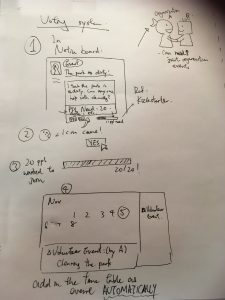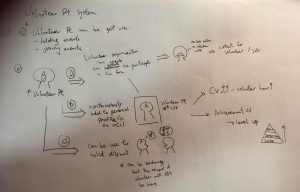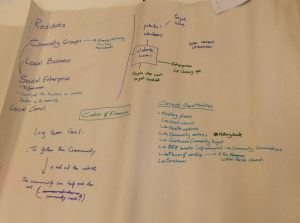Reflection and Summary of the User Interviews
We have arranged two Users Interviews in Walker on 21st and 26th October respectively. On our first interview, we have met Alice McCreadie, project development worker in Worker’s Educational Association and the other two clients Will Benson, manager from Kids Kabin, a charity for children (primary school students) and Gerard New from Tyneside Outdoors, an outdoor youth work organisation which provides young people skills and opportunities. They encourage people to learn and build. The WEA project in Northumbria and Building Future East helps people who want to start a new business and act as a community directory in sharing of resources. On the second interview, we have met Bud Russell and Liz Coates from Worhoose, Francesca Maddison from Building Futures East.
They stated that usually University students, Local Residents, International volunteers as well as parents of the children and youngsters who benefits from the organisations get involved in volunteering, some ex young-groups participants came back as volunteers but drop in and out occasionally. Students come more often but some may come for placements and experiences. They picture the motivation and the way they wanted to volunteer. However, most of the people only volunteer when they know how to deal with the project. Volunteers may lack of confidence when they experience barriers such as application forms. They are afraid of failure. Volunteers may participate in it because their families and friends have received the services before and they have had loyal to it. Parents who wanted to volunteer but haven’t been able to commit and not consistent. Problems with housing and children as well as financial stuff, utilities compulsory and debt. Students are more free and available. But the inconsistency of young person is a problem. They don’t based in the same place and maybe have issue to deal with and cannot arrive on time.
Our aim is to motivate and encourage more people to volunteer in the local area. Clients think that the best way to inspire and develop potential volunteers themselves is illustrating to them the benefits of the volunteering. Build up the strong of pride and unity in Walker. They often said that they want to bring the community together but none of them execute the idea. By offering more opportunities for people to share their resources, such as funds, can help achieving the social needs. People will be attracted to get on volunteering if they are sure that they can have reward and opportunities. However volunteers may come only for reward, such as for CV purpose.
In order to promote our initiative, setting up a webpage and encourage everyone to be on that, increase residents motivation to click on the link, also Get to advertise the organisation and their base through giving out handbooks. Most kids have phone nowadays. According to Will, he will use website for research but not Facebook. Most parents use Facebook but they don’t allow young people to use . School only admit Facebook for age 13+. Sometimes social media might not be an ideal platform for promotion. As we would like to encourage volunteers in a digital way, Internet access is more important as wifi limited throughout the area. The Pottery bank got a suite of computer to offer. The Local mapping idea with tag and present all the barriers, avoid hidden information will help people to know the base for volunteering, so to persuade them to volunteer easily. Other than network, handbook giving to door not run by company but well written might work. It has games, section with local communities group put up their news, spreading their group and organisation around the area. Finding help from local people through the handbook instead of from web found people from elsewhere. It also creates local identity, encourage people to start looking at it. Creating the handbook can be a social enterprising, strengthening social cohesion and awareness of what surround you.
In order to run the project smoothly, we need to encourage local businesses for social reinvestment. They have political investment, they want to invest in a project with good outcome and 100% productive, well prepared, best quality and best time. If these are all possible they will continue to support. We have also concerned about the role of local authorities, the clients suggest that they should have participation but they shouldn’t have a role in it. The initiative is acting for the community’s social health, the authorities should have responsibility to buy and share them as local residents don’t have money and expertise to do it.
Other than our proposed initiative, Building Future East has an education course for the benefit of young people in the area, formal education allows higher education for adult to get back into job.
In Conclusion, our clients looking towards the summer putting together a programme for a family to go in the website and the handbook. Summer holiday planner including activities for different ages, different opportunities for different days. Therefore, volunteers and participants can know whats coming on.


